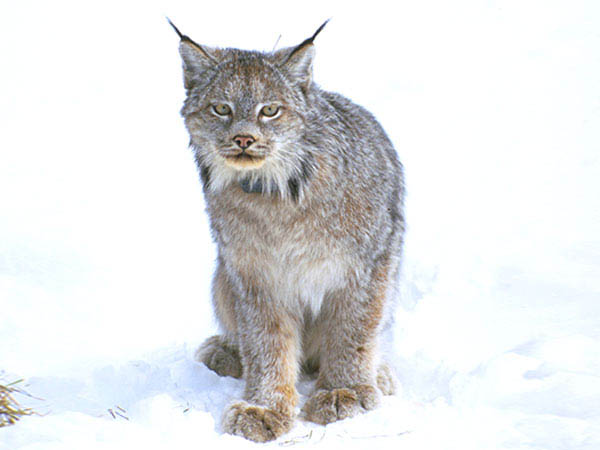I have seen a fair amount of wildlife in my time as a field ecologist and wilderness trip leader, but I have only caught one fleeting glimpse of this elusive forest cat. The lynx loped across the road on its huge paws, taking high graceful steps with overly long legs. The cat briefly turned its head to acknowledge our visitation, looking us over with its beard-like mane and large, tasseled ears before walking off into the wilderness. This lynx appeared and disappeared so easily in the vast boreal forest of Alaska—making no sound and taking no heed of intruders—that it left me with a sense that I had been visited by a mythical creature out of a J.R.R Token novel.
Ever since that encounter I have kept and eye out for Canada lynx (Lynx canadensis) in the mountains and forests of northeast Washington. The north Cascades, Kettle Range, and Selkirk Mountains are the southern range for this woodland cat, where there are between 20 and 100 resident lynx.
Canada lynx play an important ecological role in their boreal (northern) forests. These mid-sized forest hunters target smaller prey species that reproduce quickly: voles, mice, grouse, and red squirrels. But the Canada lynx’s preferred prey is the snowshoe hare. The hare is so important to a lynx’s diet that lynx population numbers closely follow the population cycles of snowshoe hare.
These cats are perfectly suited to live and hunt in northern conifer forests where deep snow accumulated in the winter. They have large, fury paws and long hind legs to aid them in bounding through the snow after their hopping prey. Their large ear tufts and keen eyesight help them locate a white snowshoe hare against the snow.

Lynx utilize a variety of habitats in cool spruce-fir forests. Lynx hunt where snowshoe hare are the most abundant— in young forests with dense understory. They have their kittens in mature forests where downed logs and large root systems create ready-made dens.
In 2000 the Canada lynx was listed as threatened under the Endangered Species Act (ESA) in the lower 48 states due to low population and lack of regulation on public lands to protect the species’ habitat. This spurred an increase in the understanding of lynx biology, including population numbers and their need for both young and mature forests.
The listing of Canada Lynx has spurred federal land managers and private land owners to take actions to conserve both lynx and hare habitat. The US Forest Service (USFS) Rocky Mountain region put conservation measures in place. In Maine, woodland landowners identified 2.5 million acres of forest for the benefit of lynx habitat.
Here in Washington, logging and road building projects have been directed to protect critical habitat on federal lands. The Washington Department of Fish and Wildlife (WDFW), Washington State University (WSU), non-profit conservation group Conservation Northwest, and other organizations have been working to reduce mortality from fur trappers and increase data on lynx population numbers, including using game cameras to document sightings in Northeast Washington.
As of this year, the US Fish and Wildlife Service (USFW), along with recent changes to the Endangered Species Act, is now proposing to delist the Canada lynx. Even though populations are still low, the USFW has deemed that conservation efforts are sufficient to protect this species’ habitat. The USFW report also states that climate change will not reduce lynx habitat and availability of snowshoe hare. Some scientists and wildlife advocates do not agree and believe that changes to forest structure and reductions to snowfall brought on by climate change will threaten population numbers. This data on how climate changes affects northern forests was used to keep another snow loving species, the wolverine, on the ESA list.
Regardless of the Canada lynx status with the Endangered Species Act, Canada lynx have been a great example of how the ESA spurred federal, tribal, state, and private landowners to work together to protect habitat. This listing has also benefited the snowshoe hare and other species that utilize a mosaic of young and mature northern forests in the lower 48.
I for one will keep an eye out for these mysterious cats walking silently through our northern forests and hope their population continues to grow.












